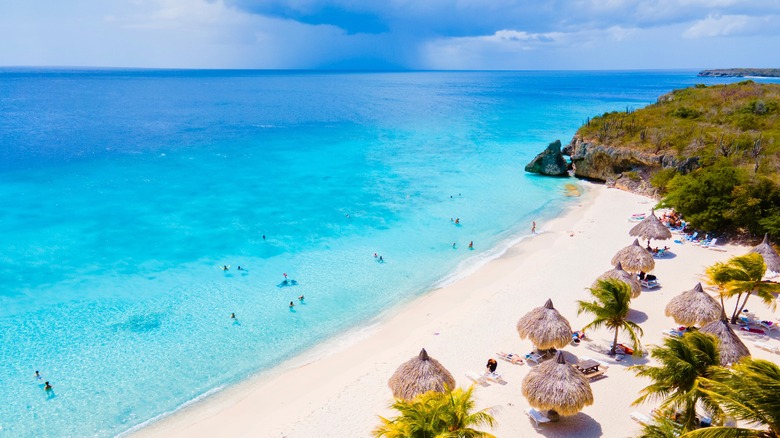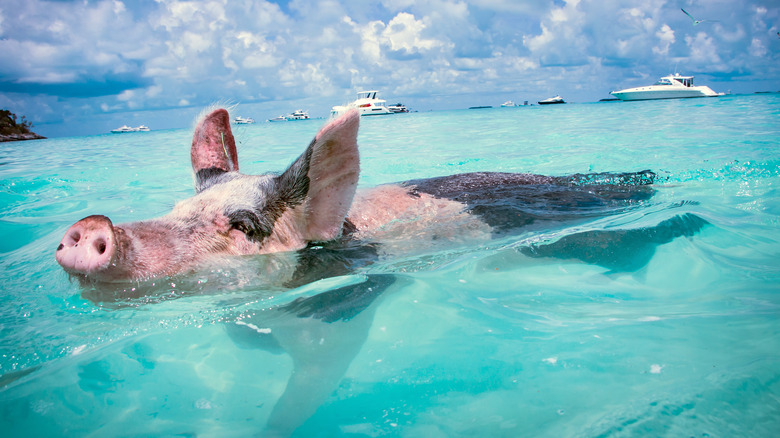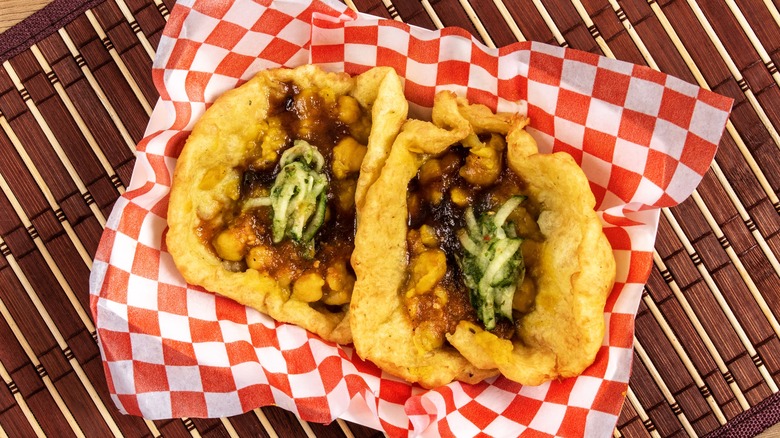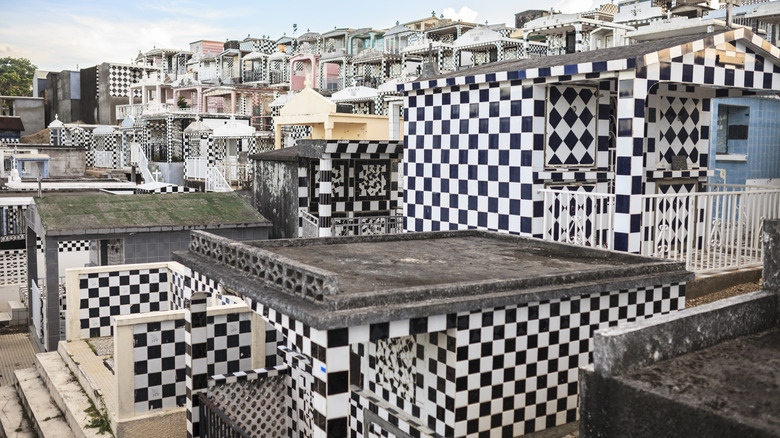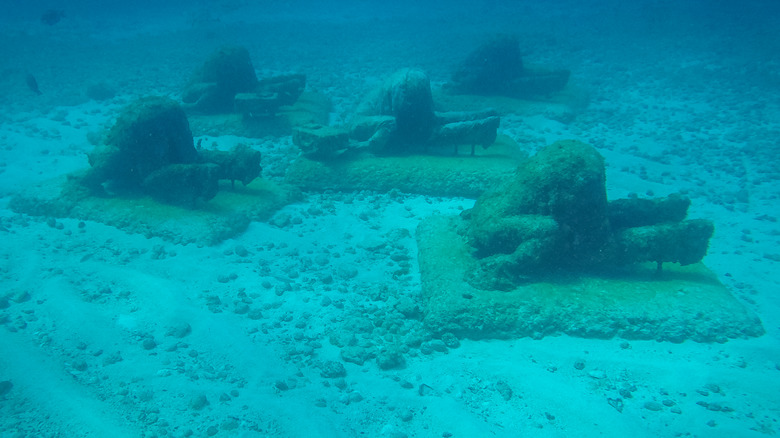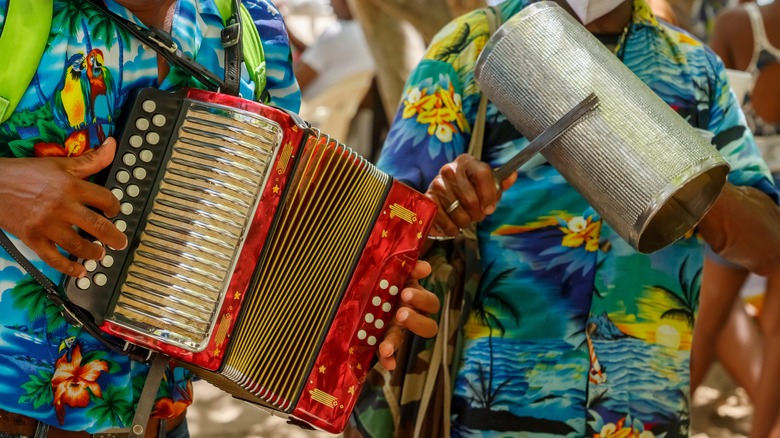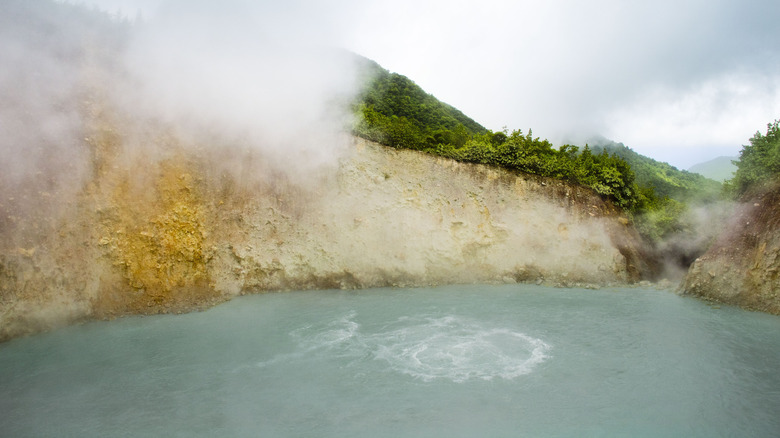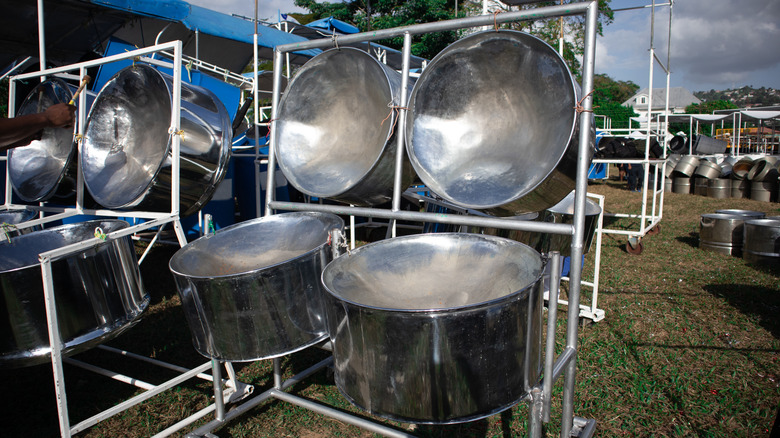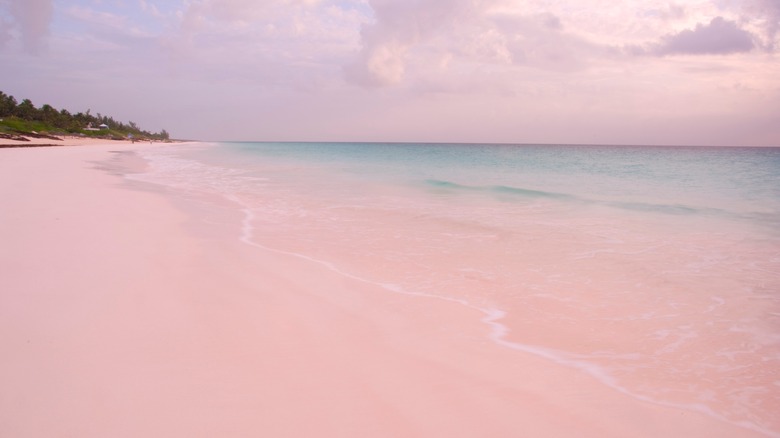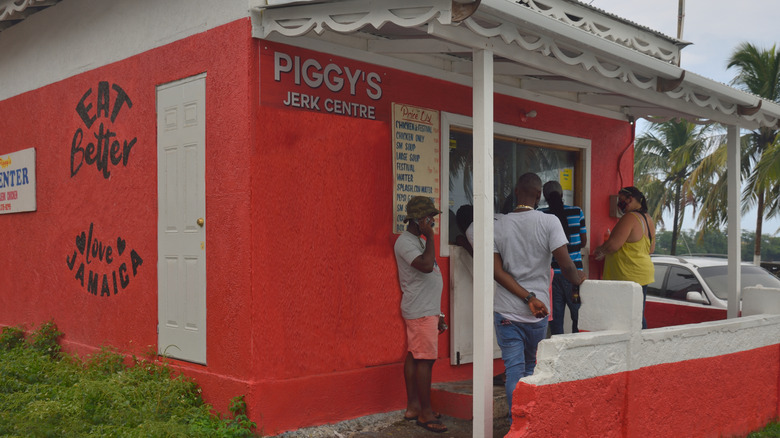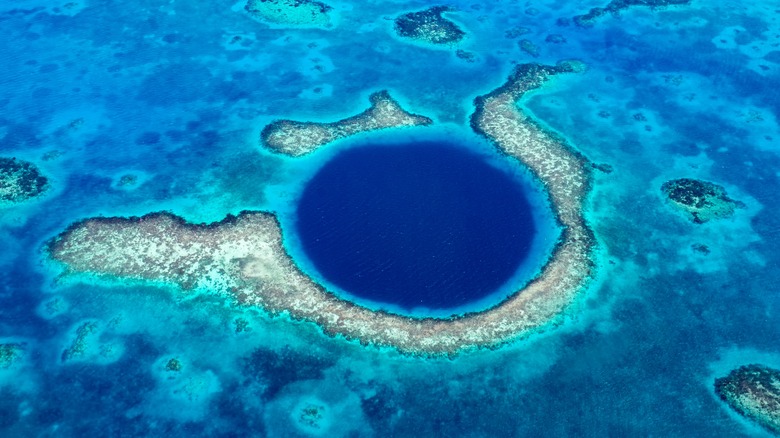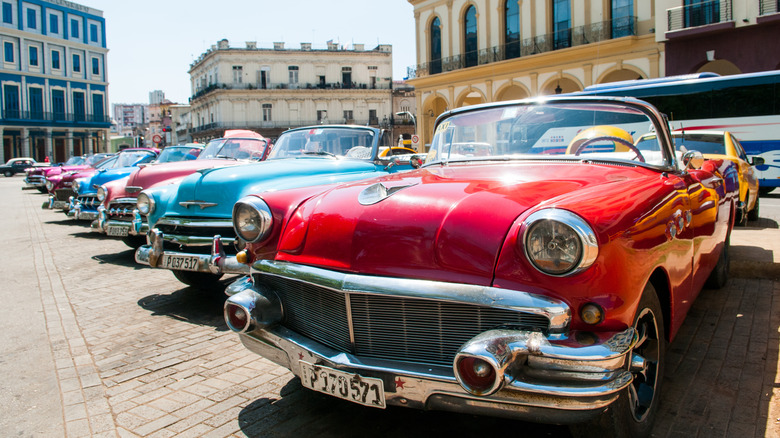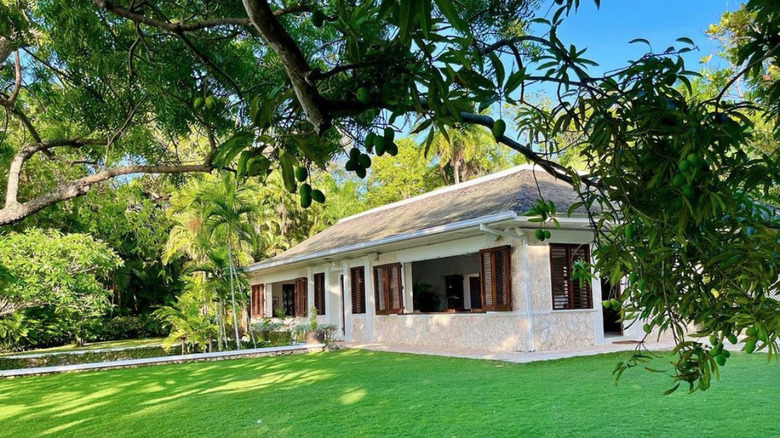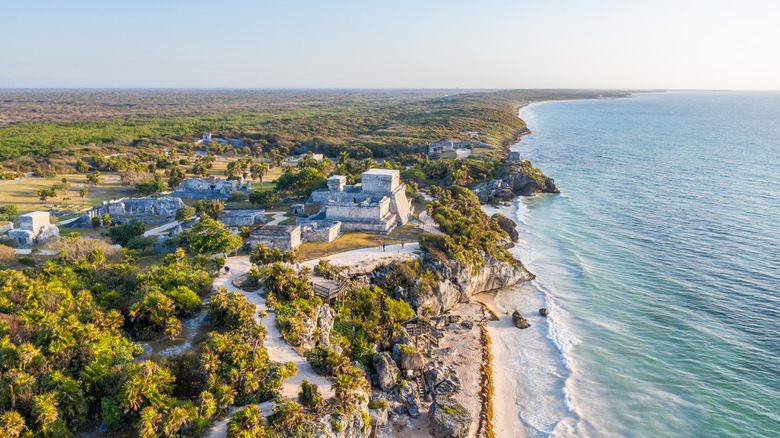Unique Experiences You Can Only Have In The Caribbean
Thanks to its sun, sand, and sublime seas, the Caribbean needs no introduction as a vacationer's paradise. Travelers arrive in droves each year to enjoy the islands and destinations around the region's namesake sea. Many voyagers explore mountains, rainforests, and ruins; others head to the beaches — an unsurprising choice, given that the Caribbean has some of the best islands for snorkeling in the world.
Families hoping to enjoy a relaxing break without fears over security can look forward to a stress-free vacation on the many safe Caribbean islands. Travelers can choose from a host of unique adventures across the area, covering many facets of life and appealing to different interests. Some options will entice thrill seekers, others will appeal to fans of culture, and there are even treats in store for foodies. No matter what brings you to the Caribbean — including the Atlantic islands of the Bahamas — you can expect to encounter features you won't find at any other destination.
Swim with pigs at the Bahamas' Pig Beach
Many travelers know about Stingray City, a sandbar off the coast of Grand Cayman where visitors can book a tour and swim with friendly stingrays. On such an excursion, a person might find themselves in the company of 50 of the graceful, swooping creatures. Since the rays have grown accustomed to humans, they often swim up close, some even brushing by a visitor's leg (as we have experienced firsthand). However, even tourists who have visited the denizens of Stingray City might not know that they can swim with pigs in the Caribbean.
The action occurs on Big Major Cay, also known as Pig Beach. The small, uninhabited island southeast of Exuma Cays Land & Sea Park is one of the best places to snorkel in the Bahamas. Legends surround the origins of the pigs on Big Major Cay, with one theory suggesting they survived a shipwreck and swam there. Nowadays, the pigs live peacefully on the cay, and volunteers from nearby islands work to ensure their wellbeing. The swine also get regular visits from tourists eager to experience this unique opportunity. They can even bring food to feed the animals, with the Bahamas Tourism Center recommending fresh fruit. Travelers can only reach Big Major Cay by boat, so they must plan ahead to check this activity off of their bucket list.
Try doubles in their homeland
An enticing street food invented in Trinidad that we've eaten many times, doubles, derives from the Indian dish chole bhature. It has a simple setup. The server ladles curried chickpeas (known locally as channa) on top of a small, unevenly shaped piece of flatbread. Then, they add various pickles, chutneys, and sauces atop the channa. They cover the colorful combination with another piece of flatbread — hence the name doubles — making it look vaguely like a sandwich. But unlike a finely packed sandwich, doubles aren't a tidy item to consume, with sauce oozing out and inevitably spilling onto the eater's fingers. Thankfully, the taste is more than worth the mess.
From the fragrant channa and the sweet-sour tamarind to the acidic pickled cucumber and mango to the fiery pepper sauce, doubles create a symphony of sensations and flavors in the mouth. Their origins trace back to Princes Town, in the south-central part of Trinidad, created by the Deen family in 1936. Today, visitors will find doubles all over Trinidad — though less prevalent in sister island Tobago — especially in the morning as a popular breakfast dish. Travelers can choose from multiple stalls at the Doubles Strip in Debe, south of San Fernando.
See a checkerboard cemetery in Guadeloupe
Many individuals view cemeteries as somber places; after all, people go there to remember the dead. On the French island of Guadeloupe, however, one graveyard has injected a bit of life into its design. Morne-À-L'Eau cemetery features tombstones with an arresting checkerboard pattern, a stark departure from the usual faded gray stone that serves as a hallmark of many cemeteries. It makes for a surprising sight when looking around the 1,800 graves there arrayed in an amphitheater formation.
Sharp, tightly packed sections of black and white, like giant chess boards stuck on the sides of graves, spread in all directions. Some tombs almost appear like small dwellings, complete with terraces and roofs. The cemetery is located in the northeast of the island and is a popular place to visit, even for tourists. The largest crowds of the year appear on All Saints Day when visitors light candles around the graves, and enterprising vendors sell sandwiches and peanuts to attendees. These activities create an almost festive atmosphere.
Snorkel among underwater treasures before dining on a pirate ship
Located between Cancún and Isla Mujeres, MUSA, a vast trove of underwater sculptures split between two sites, is a dreamland for art-loving divers and snorkelers. The Manchones site by Isla Mujeres, the island northeast of the Cancún hotel zone, features more than 450 sculptures. Since some of them sit more than 30 feet underwater, this section is suited to divers. One provocative piece shows figures with their heads buried in the sand. The other display is by Punta Nizuc, in the southern portion of the hotel area. The artwork isn't very deep in the water, some less than 10 feet below the surface, making it suitable for snorkeling. Visitors can see pieces like figures sitting around a table or a person on a couch watching television.
After some aquatic art, there is more marine fun to be had in Cancún. Jolly Roger is a replica pirate ship modeled on the Santa Maria vessel used by Christopher Columbus. The ship has a modern skeleton, but its exterior, with three masts made of wood, gives it an old galleon feel. It houses a dinner and a pirate show, supported by modern audio and visual equipment. Entertainers come decked out in full costume, and guests can enjoy live music, performances, and fireworks. Visitors are also welcome to dress the part.
Dance to merengue in its native home
Originating in the Dominican Republic, merengue is a rapid, rhythmic form of music and dance. Visitors to the country will likely hear it throughout their travels, blasting out from cars that zip around the roads or emanating from small shacks selling food. It's an intrinsic part of Dominican culture, so much so that Unesco has afforded it Intangible Cultural Heritage status. November 26 is set aside as National Merengue Day each year. Over the summer, the Dominican capital, Santo Domingo, comes alive during the Festival de Merengue, with events centered on Avenue Malécon in the city's heart.
However, travelers don't have to wait until those specific windows of time to enjoy the art form in its homeland. There are many clubs across the country where merengue is the unerring soundtrack for the night. For instance, the Merengue Club in Santo Domingo gets good reviews on Tripadvisor. In Puerto Plata, a beach town on the north coast, places like Bohemios and Charly's Bar are hangouts where merengue is typically played. Finding a spot to hear and dance to merengue in small towns won't be hard. We usually uncovered them through word of mouth during our travels to the Dominican Republic.
Hike to the largest boiling lake in the Western Hemisphere
The volcanic island of Dominica is primed for nature lovers. While many Caribbean islands are known for their beaches, Dominica has a lush, rugged landscape as the main draw. This place features towering mountains topped by dense tree cover, sheer cliffs, winding rivers, and endemic birds like the smaller red-necked parrot. Another lure is the hiking, including the arduous trek to a lake where the water is actually bubbling. It's the second-biggest boiling lake in the world (the largest is in New Zealand). Getting to it is an arduous journey that we have completed and requires a full day's commitment.
During the trip up to the lake, which sits more than 2,000 feet above sea level, adventurers will pass through an area called the Valley of Desolation. The scenery varies along the way, from patches of greenery to arid spots and bits of slippery scree. Travelers must use their hands and legs to tackle steep inclines in some sections. Sometimes, the surroundings feel so otherworldly and remote that visitors might not even feel like they are on Earth. But the terrain and danger are real, and hikers need to tread carefully — definitely use a guide. The lake is 200 feet across, often shrouded by vapors rising from its surface. Look closely, and you can see the water bubble and pop.
Visit the home of steelpan
Anyone who has heard the distinctive timbre of a steelpan will know how the sound has a way of transporting the listener. It's a melodic, airy tone that takes you away to an island where the sun is always shining and everyone around you is constantly smiling. Steelpans were created in Trinidad almost a century ago, but their roots reach back much further. Enslaved Africans taken to the island in the 1700s brought their drumming traditions, and hand percussion instruments became a key part of annual festivities. The British later banned the drumming, but inventive locals used bamboo sticks to recreate the sound, incorporating pieces of scrap metal into the ensemble. Eventually, metal became the main medium for percussion, and drummers found that raised parts of the metal produced different pitches and tones.
Today, a steelpan looks like a molded, grooved-out metal hollow. Made from old oil drums, it has small indentations inside the bowl that allow users to create variations in pitch and melody. Laventille, an area of the capital Port of Spain, is credited as the birthplace of steelpan. The instrument is inextricably tied to Trinidadian identity and is of such cultural significance that the United Nations declared August 11 as World Steelpan Day. Tours in Port of Spain take visitors to pan yards around the capital and let travelers experience the lilting rhythms on its home turf.
Island hop between pink sand beaches in the Bahamas
Pink-sand beaches aren't a phenomenon exclusive to the Caribbean. Travelers can find them in Bermuda, Indonesia, Australia, and California. The unusual color is often the product of degraded shells of marine creatures washing up on the shore. In the Caribbean, visitors can enjoy pink sand beaches on Barbuda and Bonaire or head to the Bahamas for a selection of them. Better yet, if they are nautically inclined, they can shuttle around the various islands on a boat and visit them all. The most famous beach is probably on Harbour Island, on its east coast, which yields to the Atlantic. It's a deep beach, about 100 feet front to back in some sections, and spreads along three miles of shoreline. The sand really is a luminous pink.
Travelers can take a leisurely boat ride from Harbor Island southeast to French Leave Beach on Eleuthera. Sometimes known as Club Med Beach, after a former resort that once stood there, the sand is flecked with pink and extends for more than 1 mile along the coast. Visitors with boats can find a mooring in French Leave Harbour and make the 15-minute walk to the beach. One visitor on Tripadvisor raved that this is the "best beach we have ever been to, amazing water & pink sand, uncrowded." Expect a longer boat ride from this beach to Cat Island, where an 8-mile stretch of pink sand beach awaits. It's located on the west coast, south of the airport, and is often crowd-free.
Eat jerk chicken where it was invented
Many people might consider the word "jerk" a pejorative term, but for Jamaicans, it's also used to describe a beloved culinary treasure. Jerk is a form of preparing meat through a combination of seasoning and cooking. It employs lively ingredients like garlic, thyme, cinnamon, and fiery scotch bonnets, the bulbous peppers that pack a killer punch. The method of jerk owes its existence to the native Arawaks, or Carib Indians, and the Maroons, formerly enslaved people in Jamaica who escaped to the mountains. Early versions of jerk meat were cooked in underground pits — this ensured there was no smoke, helping the escaped enslaved people to avoid detection.
Nowadays, dwellers of some large cities in the U.S. can buy jerk seasoning to recreate the jerk flavors at home. For a more authentic rendition of this gustatory marvel, head to Boston, in the northeast of Jamaica. It's cited as the place in the country where jerk was born and remains a key center for the smoking, grilling, and selling of jerk meat. Some of the jerk pits at the Boston Jerk Center are more than 80 years old, and while jerk pork has been the historical mainstay, jerk chicken and shrimp are also available.
Swim in the world's largest blue hole
There are many reasons divers might put Belize on their travel bucket list. It has hundreds of islands, almost 200 miles of coast, and the longest intact barrier reef in the Western Hemisphere. It also has the Great Blue Hole, the biggest underwater sinkhole on the planet. You might have seen photos of it, appearing like a giant eye that peers up from the sea. It's a portal to a hidden realm where thrill-seeking divers can try out their scuba gear. Almost entirely surrounded by fringing reefs, the hole has a deep blue shade contrasting with the nearby turquoise seas. The color speaks to the depth of the formation, an underwater sinkhole that plummets down more than 400 feet. It's large and deep, about 1,000 feet in diameter, and formed thousands of years ago.
While it's an unusual sight from above, the real bounty awaits below the surface. Underwater divers will see limited marine life, perhaps a reef shark or two, but they can experience subaquatic caverns and stalactites, which are common features of cave complexes. As one diver on Tripadvisor put it, "Come prepared to be blown away by the immensity of the sunken cave structure, the huge stalactites that were formed over thousands of years, and the vastness of the deep, dark waters off the sandy shelf."
Watch 1950s cars cruising Cuba's streets
Unless you go to a classic car meet-up or exhibition, you will not likely see hundreds of 1950s American cars in one fell swoop. But visit Cuba, and you'll spy plenty of old classics doing the rounds on the streets. This anachronistic set-up is a remnant of the economic sanctions President Kennedy imposed on Cuba in 1962, a move that had lasting repercussions on the island. In the aftermath, imports of American cars stopped — the U.S. is less than 100 miles from Cuba — meaning that the types of vehicles left on the island were 1950s-era models like the Ford Fairlane and the Chevrolet Bel Air.
Through necessity and ingenuity, Cubans have kept these classic cars running. While other, more modern vehicles populate the island's roads, these bangers have made a name for themselves as bona fide tourist attractions that attract travelers from all over the world. Some are even used to ferry visitors around Cuba to locations near and far.
Stay at the James Bond villa
Ian Fleming had a background as a journalist and an officer in the British Navy during World War II. But it's probably not either of these careers that pop culture followers will remember him for. Moving to Jamaica after the war, Fleming retired to a villa a short drive from Ocho Rios and penned 14 "James Bond" books there. "James Bond" is now a global phenomenon, a franchise that extends to multiple movies, and a name that epitomizes the sensibility of unwavering cool among earth-shaking calamity.
Some think Fleming styled Bond on himself — Fleming was often seen wearing a silk scarf around his neck while nursing a drink in his hand. While this is possible, what is known is that Fleming chose the name James Bond from the ornithology book, "Birds of the West Indies." The book's author was James Bond. The Fleming Villa, once called GoldenEye, is on Oracabessa Bay and is now available for rent to travelers. It has its own beach, pool, gardens, and even a butler, cook, and housekeeper. Comprising a main house and two separate cottages, it can house 10 guests — even international men of mystery are welcome.
Tour a Mayan ruin by the sea
Mayan ruins dot the plains and jungles of Mexico's Yucatan Peninsula — from the grand Chichén-Itzá to the hidden complex of Coba. But only one set resides by the sea. On the Riviera Maya, south of Cancún, the ruins at Tulum sit on a cliff above the Caribbean Sea. High up, the structures command a view over the serene turquoise shallows below. Tulum was built in the 1200s, the only Mayan settlement by the coast. The location was no coincidence, as Tulum served as a seaport, with precious stones among the cargo traded.
A sturdy, tall wall encloses the site, stretching thousands of feet around the city. Within the walls, visitors will find gentle hills and remnants of buildings that formed the skeleton of the town. The most famous building might be the Castillo (it means castle in Spanish). Perched on a limestone cliff above the sea, it's often the structure you might see in a promotional shot of the ruins. From first-hand experience, we can tell you it's a stirring and unique sight, with dull, weathered stone set against the vibrant Caribbean Sea.
